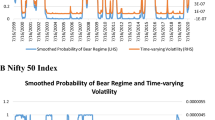Abstract
The increasing globalization of economies and the concurrent increase in the risk of currency exposure has stimulated the development of new instruments to allow both investors and traders to hedge their currency risk. The expansion of these derivatives, however, has raised some concerns. This paper studies the determinants of the dynamics of exchange rate future contracts as a means to identify the sources of such concerns. By using a mean-exponential generalized autoregressive conditional heteroskedasticity (M-EGARCH) model for five different future contract lengths and six developed economies, it is found that an M-EGARCH(1,1) effectively describes the exchange rate futures' daily dynamic. Sign, size, and persistence effects on the volatility of future contracts are all significant, thus providing important information to both policy makers and market participants.
Similar content being viewed by others
References
Baillie, Richard T.; Osterberg, William P. “Central Bank Intervention and Risk in the Forward Market,”Journal of International Economics, 43, 1997, pp. 483–97.
Berndt, E. K.; Hall, H. B.; Haussman, J. A. “Estimation and Inference in Nonlinear Structural Models,”Annals of Economic and Social Measurement, 4, 1974, pp. 653–66.
Bollerslev, Tim; Chou, Ray Y.; Kroner, Kenneth F. “Arch Modeling in Finance,”Journal of Econometrics, 52, 1992, pp. 5–59.
Boothe, Paul; Glassman, Debra. “The Statistical Distribution of Exchange Rates: Empirical Evidence and Economic Implications,”Journal of International Economics, 22, 3–4, 1987, pp. 297–319.
Cavanaugh, Kenneth L. “Price Dynamics in Foreign Currency Futures Markets,”Journal of International Money and Finance, 6, 3, 1987, pp. 295–314.
Chappell, D.; Padmore, J.; Ellis, C. “A Note on the Distribution of BDS Statistics for a Real Exchange Rate Series,”Oxford Bulletin of Economics and Statistics, 58, 3, 1996, pp. 561–6.
Datastream. <http://www.dstm.com>, 2000.
Engle, R. F. “Autoregressive Conditional Heteroskedasticity with Estimates of the Variance of U.K. Inflation,”Econometrica, 50, 1982, pp. 286–301.
Engle, R. F.; Bollerslev, T. “Modeling the Presence of Conditional Variance,”Econometric Reviews, 5, 1986, pp. 1–50.
Flood, Robert P.; Garber, Peter; Kramer, Charles. “Collapsing Exchange Rate Regimes: Another Linear Example,”Journal of International Economics, 41, 3–4, 1996, pp. 223–34.
Garber, Peter; Spencer, Michael G. “Foreign Exchange Hedging and the Interest Rate Defense,”International Monetary Fund Staff Papers, 42, 3, 1995, pp. 491–515.
Glassman, Debra. “The Efficiency of Foreign Exchange Market Futures Markets in Turbulent and Nonturbulent Periods,”Journal of Future Markets, 7, 3, 1987a, pp. 245–67.
__. “Exchange Rate Risk and Transaction Costs: Evidence from Bid-Ask Spreads,”Journal of International Money and Finance, 6, 4, 1987b, pp. 479–90.
Glassman, Debra; Riddick, Leigh A. “Why Empirical International Portfolio Models Fail: Evidence that Model Misspecification Creates Home Asset Bias,”Journal of International Money and Finance, 15, 2, 1996, pp. 275–312.
Inclan, Carla. “Use of Cumulative Sums of Square for Retrospective Detection of Changes of Variance,”Proceedings of the American Statistical Association Conference, 1993.
Kroner, K.; Jahangir, S. “Time-Varying Distributions and Dynamic Hedging with Foreign Currency Futures,”Journal of Financial Quantitative Analysis, 28, 4, 1993, pp. 535–52.
Leland, Hayne; Gennotte, Gerard. “Market Liquidity, Hedging, and Crashes,”American Economic Review, 80, 5, 1990, pp. 999–1021.
McCurdy, Thomas; Morgan, Ieuan G. “Testing the Martingale Hypothesis in Deutsche Mark Futures with Models Specifying the Form of Heteroskedasticity,”Journal of Applied Econometrics, 3, 1988, pp. 187–202.
McDonald, Roland; Taylor, Mark P. “Exchange Rate Economics: A Survey,” working paper, 39, International Monetary Fund, 1992, pp. 1–51.
Nelson, D. B. “Conditional Heteroskedasticity in Asset Returns: A New Approach,”Econometrica, 59, 1991, pp. 347–70.
Obstfeld, Maurice. “The Logic of Currency Crises,”Cahiers Economiques et Monetaires, 43, 1994, pp. 189–213.
Obstfeld, Maurice; Rogoff, Kenneth. “The Mirage of Fixed Exchange Rates,”Journal of Economic Perspectives, 9, 1, 1995, pp. 73–96.
Taylor, Mark P. “The Economics of Exchange Rates,”Journal of Economics Literature, 23, 1, 1995, pp. 13–47.
Author information
Authors and Affiliations
Rights and permissions
About this article
Cite this article
Aguirre, M.S., Saidi, R. Volatility behavior of exchange rate future contracts. Atlantic Economic Journal 28, 396–411 (2000). https://doi.org/10.1007/BF02298393
Issue Date:
DOI: https://doi.org/10.1007/BF02298393




